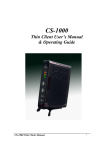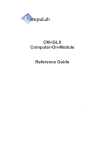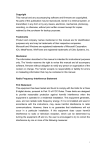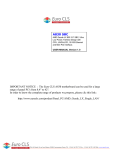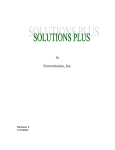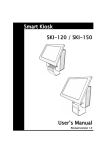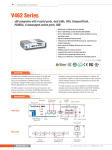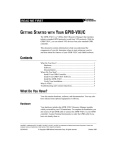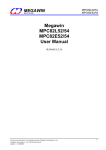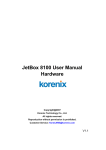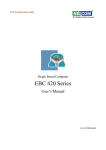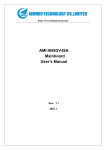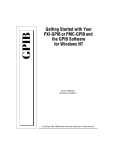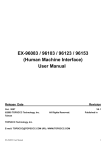Download CS-800
Transcript
CS-800 Thin Client User’s Manual & Operating Guide CS-800 Thin Client Manual 1 Index I. Introduction………………………………..….3 What is Thin Client? Why Thin Client?……………………………………………...4 Advantages of Thin Client……..…………..……………..….5 How Does Thin Client Works………..…………..…………..5 II. The CS-800 Hardware Specification ….….8 a. Description of hardware………………………………..…8 b. Hardware Configuration………………………………..…8 c. Mother Board Details……………………..…..…………..8 d. Power Adapter Specifications……………………………9 III. Quick Start Guide…………………….….. 10 IV. Trouble shooting…….………………...…. 11 CS-800 Thin Client Manual 2 I. Introduction What is Thin Client? Thin Clients are the next generation of computing. They are small, affordable, easy to maintain, reliable, and secure. The Thin-Client device is a simple terminal or other computing device connected to powerful servers where applications and data are stored and processed. Thin Client is a generic term used to describe a group of technologies that provide a reduction in total cost of ownership through a combination of reduced hardware costs, reduced maintenance and support costs, reduced LAN/WAN bandwidth requirements, reduced downtime, reduced in infrastructure, reduced in power management, improved performance, and enhanced security. The term Thin in ‘Thin-Clients’ refers to the very small size of the client operating system. In contrast, PC Operating Systems are considered ‘Fat’, as they are very big in size. Despite the fact that the Thin-Client OS is very Thin, the capabilities of ThinClients are very robust. Thin Client technologies are deployed today in MissionCritical and are providing reliable and responsive access to many applications. The idea of thin-client / server computing might cause a case of deja-vu. Thin clients are not a return to mainframes. They are the next step in the evolution of computers. The first computers were massive "mainframes" that users accessed through "dumb terminals", a simple monitor and keyboard using text commands. Mainframes computed over slow networks using proprietary software. They provided a secure, reliable closed system for mission critical tasks. CS-800 Thin Client Manual 3 Personal computers freed computing power from the backroom and made it available at every desk with an easy-to-understand "graphical user interface" (GUI). Advancements in network technology made it possible to send larger packets of information across networks at faster rates. It made sense to network personal computers to share resources and move data. The desktop control that made personal computers so appealing also made them increasingly complex, a challenge to support, and limited users' ability to collaborate. Thin clients simplify management and allow multiple platform computers to share resources seamlessly. Like a mainframe, they rely on a server, where resources and maintenance can be centralized, but they also run the latest productivity software and have an easy-to-use GUI interface like a personal computer. Some districts may use all three: mainframes for mission critical data, personal computers for teachers to try out new software, and thin clients for general use. Why Thin Client? Market research suggests that Thin Client Technologies can replace 50-70% of PCs now in place in corporations. The reasons for this are – 1. Centralized Management of data considerably reduces costs. 2. Corporations nowadays require universal access to data and applications, independent of Connectivity and Platform (both Software and Hardware). 3. Businesses today depend on Employee Access to critical information at the press of a button. So, it is cheaper to use more number of Thin-Clients. 4. Security from Viruses is greater with Thin-Clients, as the user’s ability to introduce viruses into the network is restricted. 5. Represents reliable systems with far less downtime. 6. Eases budget and lower total cost of ownership. Can reduce total cost by 50 percent over 5-year period. 7. Are robust systems that are tamper proof and easy to handle? Advantages of Thin Client over Desktop PC's 1. Protection from obsolescence. 2. Never change your desktop workstations again since they are used as Windows terminals. 3. Easily distribute software, by installing it once on the server. 4. Easily centrally administer and manage the entire network (LAN &WAN) from a single console. 5. Logical server farms can contain many CPUs in various locations, but act as one logical server to manage. 6. Easier help desk support. 7. Any problem can be seen at the help desk no matter where in the LAN /WAN the user resides. CS-800 Thin Client Manual 4 8. The help desk Personnel can take control of the workstation involved. Problems can be resolved at the server level. 9. Easier web publishing. Win frame, WTS, and Lift-Off are all low bandwidth protocols. They use between 2.0KB (for Lift off) 19.5 KB per user (for WTS)! Plug-in exists for Explorer and Navigator and application can run over the web without the need for JAVA, HTML, etc. 10. Total cost of ownership is very less. How Does Thin Client Works Terminal Services provides remote access to a server desktop through "thin client" software, serving as a terminal emulator. Terminal Services transmits only the user interface of the program to the client. The client then returns keyboard and mouse clicks back to be processed by the server. Each user logs on and sees only their individual session, which is managed transparently by the server operating system and is independent of any other client session. Client software can run on a number of client hardware devices, including computers and Windows-based Terminals. Other devices, such as Macintosh computers or UNIX-based workstations, can also connect to a Terminal server with additional third party software. Terminal Services can be deployed on the server in either application server or remote administration mode. As an application server, Terminal Services provides an effective and reliable way to distribute Windows-based programs with a network server. In application server mode, Terminal Services delivers the Windows 2000 desktop or Windows NT terminal Server Desktop and the most current Windows-based applications to computers that might not normally be able to run Windows. When used for remote administration, Terminal Services provides remote access for administering your server from virtually anywhere on your network. The methodology of Windows Terminal for Thin-Client The Windows Terminal model is currently based on a set of technologies developed by Citrix Systems. Citrix Winframe is a multi-user operating system created as an authorized extension to Microsoft NT Server. As such, Winframe can support the execution of Win32, Win16, DOS, and OS/2. Multi-Win gives a Windows NT server multi-user capabilities and the ICA protocol allows the Winframe server to communicate to a variety of Thin Client devices. The Winframe server executes the applications on behalf of the clients and only passes I/O (screen and keyboard) information to the Thin Clients. On the Thin Clients in a Winframe environment ICA is virtually the only requirement, thus allowing these devices to be the "thinnest of the thin" clients. The ICA protocol stack can also be run on a traditional "Fat Client", or through ICA enabled browsers. This flexibility allows organizations to achieve a critical goal - to provide application access to any client - regardless of their platform. CS-800 Thin Client Manual 5 Citrix's Independent Computing Architecture (ICA) is a general-purpose presentation services protocol for Microsoft Windows. Conceptually, ICA is similar to the UNIX XWindows protocol. ICA allows an application's logic to execute on a Winframe multi-user Windows application server, located on the LAN. Only the user interface, keystrokes and mouse movement is transferred between the server and the client device over any network or communications protocol, resulting in minimal client resource consumption. ICA is designed to run over industry-standard network protocols, such as TCP/IP, NetBEUI, IPX/SPX, and PPP and industry-standard transport protocols, such as sync, ISDN, Frame Relay and ATM. The ICA protocol presents only the user interface from an executing machine on the display of another machine. ICA provides true location independence for Windows applications by running the Windows application at one location and executing the program's user interface somewhere else. This distributed Windows architecture allows Windows 16, Windows 32 and client/server applications to perform at very high speed over low bandwidth connections. It also allows 16- and 32-bit applications to run on legacy PCs as well as new-generation, lightweight client devices. ICA separates the application user interface from its logic. As the industry's first general-purpose presentation services protocol for Windows, ICA is being licensed to a wide range of vendors as an embeddable object in new hardware and software products. Citrix's ICA protocol has been widely adopted to deliver Windows applications to nonWindows desktops, new-generation devices and Windows terminals. The ICA protocol is designed to provide high-performance Windows display over lowbandwidth connections, to run over any common transport mechanism, and to require minimal client resources. ICA is a robust and extensible protocol that includes protocol definitions for the following capabilities: Full-screen text presentation Graphical Windows application screen presentation Keyboard and mouse input Session control Framing for asynchronous connections Error detection and recovery Encryption Compression hooks File system redirection Print redirection Multiple generic virtual channels Cut and paste across servers Com port redirection General purpose Winframe server browsing ICA is the physical line protocol used for communication between the client PC (or any other ICA-enabled client device) and the Citrix Winframe application server. Thinwire is the name of the data protocol that exports the application's graphical screen image. Thinwire is a logical data stream that flows encapsulated in an ICA packet. Thinwire is not a physical protocol. The physical protocol, ICA, CS-800 Thin Client Manual 6 must guarantee the delivery of the Thinwire data-stream with no errors and no missing or out-of-sequence data. From the perspective of the Winframe application server, the major portion of the Thinwire component is part of the GDI and video driver subsystem. This Thinwire component, in conjunction with key elements in the Winframe Win32 subsystem, generates highly optimized drawing primitives called the Thinwire protocol. The output of the Thinwire protocol driver is a logical data stream that is sent back up a virtual channel API, which takes the data-stream and encapsulates it into an ICA packet. Once the ICA packet is formed, it optionally passes through a series of protocol drivers to add functionality like encryption, compression and framing. It is then put on the transport layer and sent to the client. Once at the ICA client, the data packet passes through the same layers in opposite order, resulting in the graphical display of the remote application user interface on the client. CS-800 Thin Client Manual 7 II. The CS-800 Hardware Specification DETAIL SPECIFICATIONS Hardware Configuration Type CPU Display Monitor Memory Storage Specification AMD LXD800 Processor SVGA Color, Compatible with CRT Monitor 256Mb DDR-333 onboard FIC (Flash IDE Chip) & IDE Connector USB 4 USB Connector Audio Ethernet LAN Audio port for Speaker-output and Microphone input Support RJ-45 connector for 10/100 Base-T Ethernet Switching Adapter 12 Watts Power adapter, input 90 to 264 Volts AC 47-63Hz Mother Board Manual Processor AMD LX800 CPU on board Chipset AMD CS5536 & Realtek ALC203 Audio, U-DMA66 Function BIOS 4MB General Software BIOS PnP Flash EEPROM Windows 95/98/2000/NT/XP Compliant Ethernet Chipset: Realtek RTL8100CL 10/100Base-T Fast Ethernet controller Ethernet interface: Onboard 10/100Base-T with RJ-45 connector. PXE remote boot. Memory : Onboard 256Mb DDR-333 RAM IDE Interface Supports two IDE devices. Supports Ultra DMA/66 mode with data transfer rate up to 66MB/sec Ultra I/O On Board 4 x USB ports On-Board VGA Supports 1920x1440x32 bpp and 1600x1200x32 bpp Audio Interface On board Audio controller compatible with Xpress AUDIO, MPU-401 Interface AC97 Version 2.0 compatible Mic Interface On board Mic Input CS-800 Thin Client Manual 8 SSD Interface Supports Flash IDE Chip (FIC) Power management: I/O peripheral devices support power saving and doze/standby/suspend modes. APM 1.2 compliant Power Adapter Specifications ♦ 12 Watts, Single Output Switching Adapter ♦ Input Requirements: Input Voltage: Typical 115/230V, Min. 90VAC, Max. 264VAC Line Frequency: Typical 50/60Hz, Min. 47Hz, Max 63Hz Out put : +12V, 0.48Amp. ♦ Environment: Operating: Temperature: 0 to 45 degree Centigrade Relative Humidity - 20 to 90%, non-condensing Shipping and Storage: Temperature: -25 to +85 degree Centigrade Relative Humidity: 20 to 90%, non-condensing ♦ EMI and RFI protected Reliability: MTBF: 35000 hours min. at max. Load for 25 degree centigrade ambient temperature Mechanical Dimension: 5.2(L) x 1.12(W) x 5.58(H) Inch Weight : 0.65Kg. CS-800 Thin Client Manual 9 III. Quick Start Guide Connection Details with Drawing 1. 2. 3. 4. 5. Super VGA Connector USB Connector x 2 LAN Port DC IN USB Connector x 2r 1. Plug the power standard cord into the power socket at the back of the Thin Client (4). Connect the other end of the power cord to the wall socket for power. Thin client accepts universal power input from 100VAC to 240VAC. 2. Connect a High-resolution monitor to the socket on the Thin Client Back Plate (1). 3. Ensure that the server is connected to the same network, and make note of the server IP address. 4. Connect the monitor to a separate power socket. 5. Connect a USB mouse (1 or 5) and a USB keyboard (1 or 5) to the back plate of the Thin Client at the sockets marked for USB. 6. Now, the Thin Client is ready to power on. Power on the thin client using the Power Button on the front panel. 7. Connect the network cable from hub/switch to the Thin Client back plate at the RJ45 socket marked LAN (3). 8. Thin Client will boot up and comes to the standard screen of the Thin Client, which just appears like normal PC screen. CS-800 Thin Client Manual 10 IV. TROUBLE SHOOTING 1. If System is hangs when you start. It is the problem BIOS to do the changes in BIOS, press DEL button and enter to BIOS Setup (when system starts). The main settings that is required to change ♦ Set Date and time under STANDARD CMOS SETUP ♦ Set DRIVE C, DRIVE D and DRIVE A to None in STANDARD CMOS SETUP ♦ Set Boot Sequence to C Only in BIOS FEATURES SETUP ♦ Set Boot-up Floppy Seek to Disabled in BIOS FEATURES SETUP ♦ Set On-board FDC Controller to Disabled in INTEGRATED PERIPHERALS ♦ Save the BIOS Settings and it reboots the system. 2. Thin client is not communicating with the server. The Sever software should be Windows 2000 server Edition, Terminal server services should be enabled and CDS has to be installed on server. 3. Server is perfect still you are not able to connect to the server. The IP address of the Thin client and Server has to be in the same series like 192.168.1.x (where x value differ to server and thin client). CS-800 Thin Client Manual 11











